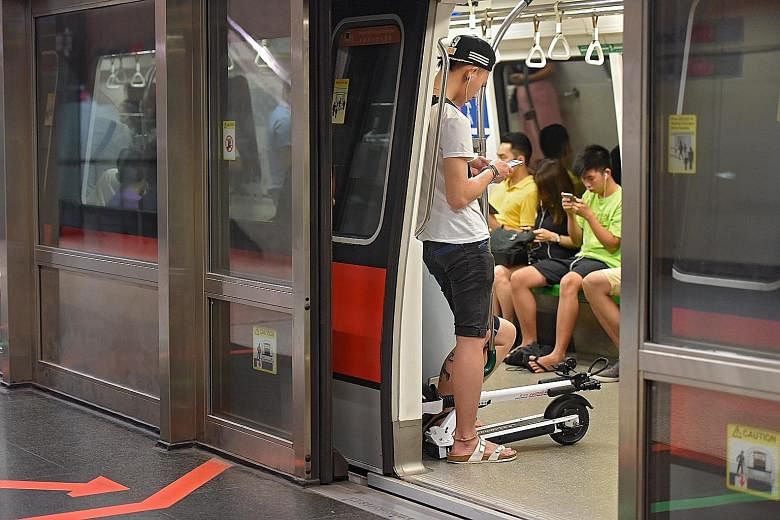SINGAPORE - As many as 2,000 commuters are now taking their foldable bicycles and personal mobility devices (PMDs) with them on board the MRT during weekday peak hours.
Since December, commuters have been allowed to take public transport with their devices in tow all day, following the launch of a six-month pilot to encourage the use of PMDs.
According to checks at some MRT stations during weekday peak-hour travel, the Land Transport Authority (LTA) said it saw an average of about 15 to 20 commuters boarding trains with their devices at each station.
With more than 100 stations islandwide, there could be as many as 2,000 commuters benefiting from the pilot. Over two million commuters ride the MRT and LRT daily.
"It is a positive indication that the trial has allowed more commuters to use active mobility for their daily first- and last-mile commutes," an LTA spokesman told The Straits Times.
The spokesman said the majority of the devices taken on board are PMDs such as e-scooters. They are more often seen at interchange stations such as Jurong East, Bishan and Serangoon, he added.
The LTA said it will monitor the situation and feedback from the public transport operators, and assess whether to continue the programme when the trial ends in May.
Mr Denis Koh, chairman of Big Wheel Scooters Singapore, an e-scooter enthusiast group, estimates that there are 30,000 PMD owners here.
With laws governing the use of PMDs on pathways to take effect later this year, and with greater clarity on the rules and regulations, he reckons that more people will be buying PMDs and using the devices as part of their commutes.
Mr Koh said he had advised members of his group - which number about 14,500 - to take the first and last train cabins so as to avoid squeezing with other commuters. He added that he has not heard of any instance where commuters with devices have been an issue.
The LTA said: "In terms of general behaviour, most commuters with devices have been considerate and followed the rules and guidelines."
Civil servant George Lim, 51, has been taking his foldable bicycle on board the MRT since December. Though he occasionally has to wait for a less crowded train during the evening peak hours, as suggested in the guidelines of the pilot, the experience has been positive.
"I can usually find a space to put my bike. You have to be considerate and let other people go first when the train is crowded," he said.
"Bus timings are not very regular, so this gives me another option when taking public transport," said Mr Lim, who cycles 1.2km daily between his home and the nearby Punggol MRT station. He suggested that foldable seats be installed in train cabins, to create more space during peak hours.
The LTA said it did not see many devices being taken on board buses. "Buses are designed to connect individuals to the transport nodes, and active mobility users are likely to use their devices in place of taking the bus, especially for shorter distances," it said.
Mr Francis Chu, co-founder of cycling group Love Cycling SG, said the narrower aisles also make it more challenging to take a foldable bicycle or PMD up the bus.
He added that bicycles and PMDs are a good substitute for taking a feeder bus, and commuters can easily cycle to MRT stations in the time it would take to wait for a bus.
"They are faster, more direct, less polluting and healthier," he said.

